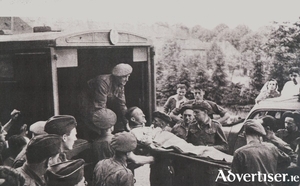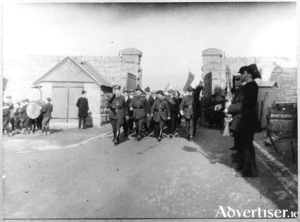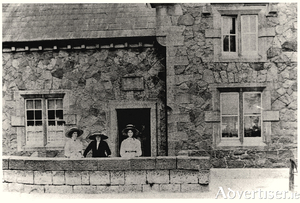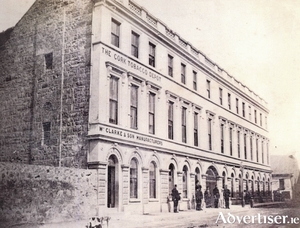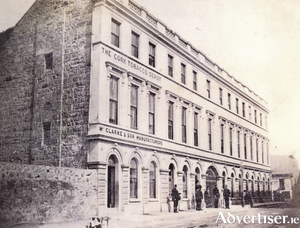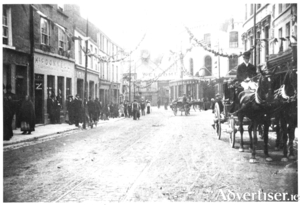Kavanagh brothers
Thu, Apr 10, 2025
Seamus Kavanagh grew up in the village of Finod, near Easkey in Co Sligo. He went to the Technical School there and the principal suggested he apply for a position as a trainee electrician with T Naughton & Sons in Galway. His colleague at work, Paschal Spelman introduced him to the Order of Malta which became a life-long interest. He did a correspondence course and qualified as an electrician. Rural electrification brought about major changes in the home, and new electric appliances were in high demand, and Seamus found himself selling these and travelling throughout the county installing them.
Read more ...Cúirt, the early years
Thu, Apr 03, 2025
When Fred Johnston was appointed as literary officer in the embryonic Galway Arts Centre, he was asked, on his first day, if he had any plans. He told the then director Dick Donoghue of a dream he had ever since reading Daniel Corkery’s book Hidden Ireland in which the author discussed how ‘courts of poetry’ which had been set up after the Flight of the Earls where poets would gather and recite their works. Fred’s idea was to establish such a court that would introduce international, national and local poets to a Galway audience, a sacred place for the celebration of poetry where it might sing again to big audiences. He did not want poetry to constitute a cultural hidden Ireland.
Read more ...‘You wouldn’t happen to be William Joyce, would you?’
Thu, Mar 27, 2025
William Joyce was born in Herkimer Street, Brooklyn, New York in 1906 to Gertrude (who was originally from Lancashire) and Michael Joyce, a native of Killour, Co Mayo. Michael had taken American citizenship, which automatically made his family citizens. In 1909, the family returned to Ireland, initially to Mayo, then to Galway.
Read more ...Clare Sheridan
Thu, Mar 20, 2025
“She was beautiful, fearsome, an English aristocrat, a communist spy, a loose woman, a middling novelist, a doting mother, an impossible parent, a successful sculptress, a respected journalist.” This was how Anita Leslie described her first cousin in My Cousin Clare, her wonderful biography of Clare Sheridan.
Read more ...Competitive rowing in Galway
Thu, Mar 13, 2025
Rowing ‘matches’ or ‘badge races’ have been taking place on the Corrib for about 170 years. Initially, when there was only one club, The Corrib Rowing and Yachting Club, competitions were confined to members. Then the Commercial Boat Club was formed in 1875, and a meeting was held to promote a regatta at the river beside Menlo Castle. This regatta proved to be a success and was a great boost to the sport of rowing.
Read more ...The turf market
Thu, Mar 06, 2025
James Hardiman, in his history of Galway lists the fuels available in Galway long ago as coal, turf and bog deal. Bog deal was mostly the roots of trees that had been grown over by the bog over the centuries. It was regarded as a nuisance by the turf cutter who likes nice clean lines as he used his sleán. The turf men usually threw this timber up on top of the bog. It gave out a lot of sparkle, like a mini firework, while it burned in the grate.
Read more ...Altar boys in the Abbey
Thu, Feb 27, 2025
An altar boy is a lay assistant to a member of the clergy during a Christian liturgy.
Read more ...The Galway & Corrib Anglers' Association, the early years
Thu, Feb 20, 2025
On February 6, 1898, Colonel O’Hara from Lenaboy Castle and Henry Hodgson from Currerevagh, Oughterard came together to found The Corrib Fisheries Association for the further improvement of trout fishing on the Corrib. They teamed up with the Board of Conservators of the Galway District to promote proper angling on the Corrib. In 1907, they managed to convince the Department of Agriculture to build a trout hatchery on the Owenriff River in Oughterard. It worked very well for a number of years but eventually fell into decline and closed down in 1924.
Read more ...Altar boys in the Abbey
Thu, Feb 20, 2025
An altar boy is a lay assistant to a member of the clergy during a Christian liturgy.
Read more ...The changing of the guard
Thu, Feb 13, 2025
On this day, February 13, 1922, the IRA took over Renmore Barracks from the British. When the Anglo-Irish Treaty was ratified on January 7, 1922, it was only a matter of time before the British Army would leave the Barracks. There was some suggestion initially that the Regional Hospital might transfer to the barracks. On February 2, the last Black and Tans had left Galway by train. The British did not want to surrender the Barracks to the Volunteers, so an arrangement was made where they would leave at a certain time, and the formal handover would take place a few hours later.
Read more ...Grattan Road buildings
Thu, Feb 06, 2025
The Galway Vindicator of November 24, 1863 reported that “The completion of the Grattan Road will add much to the beauty and salubrity of the handsomest of our suburban districts. The embankment being made by Miss Grattan will reclaim 28 acres of land, which is now a swamp, but which will become, with a little cultivation, some of the most fertile ground in the neighbourhood. Miss Grattan has given great employment to the poor of the neighbourhood in making this road and embankment. Since June last, up to the present time, there has been over 200 labourers employed and from 12 to 14 masons regularly. It will, when finished, alter the appearance of Salthill and contribute much to make that favourite watering place one of the nicest localities in the kingdom”.
Read more ...The Connacht Laundry
Thu, Jan 30, 2025
The very word laundry conjures up images of Dickensian workhouses, sweat shops, the smell of Sunlight soap, and long working hours. It is no wonder some 1,500 laundresses went on strike in 1945 for the right to two weeks' holiday.
Read more ...The lock keeper’s house
Thu, Jan 23, 2025
The Eglinton Canal was a work of great utility both in terms of draining and regulating the surplus waters of the lake and permitting ingress from the sea. The lower lake used to empty its waters through a delta by three visible outlets into the sea; The natural and original shallow tortuous and rocky Galway River, navigable only for very small craft and row-boats; The Mionlach creek, a small stream nearly filled up; “The Friar’s Cut”, about three quarters of a mile in length, fifty feet wide and twelve feet deep.
Read more ...Memories of Pope John Paul II in Ballybrit
Thu, Jan 16, 2025
On the night before the papal visit, most of our extended family moved into my brother’s house in Ballybane. No motorised traffic would be allowed near the place on the day of the event, it would be a shorter walk from Ballybane to Ballybrit, and maybe we would have a chance to get a little more sleep.
Read more ...The Colonial Buildings
Thu, Jan 09, 2025
“An important structure is now in the course of completion in ‘the citie of the tribes,’ which will supply a decided want in that hitherto neglected town, but destined – we trust at no distant period – to be a great highway from the Old to the New World. Very little indeed has been done in Galway in the way of building improvements, but a wide field is now being opened; and as transatlantic commercial intercourse increases, so must her prosperity and architectural requirements,” so began an exciting article in the Dublin Builder of January 1, 1860.
Read more ...The Colonial Buildings
Wed, Jan 08, 2025
“An important structure is now in the course of completion in ‘the citie of the tribes,’ which will supply a decided want in that hitherto neglected town, but destined – we trust at no distant period – to be a great highway from the Old to the New World. Very little indeed has been done in Galway in the way of building improvements, but a wide field is now being opened; and as transatlantic commercial intercourse increases, so must her prosperity and architectural requirements,” so began an exciting article in the Dublin Builder of January 1, 1860.
Read more ...MacDonnells of Williamsgate Street
Thu, Jan 02, 2025
In 1904, MJ MacDonnell, Confectioner, announced the fact in the local papers, that he had just opened a TEA ROOM at Number 8, Wiilliamsgate Street where ladies and gentlemen ‘can have freshly made tea and cakes – all cakes made freshly on the premises with the purest ingredients only. Seed, Plum, Rich Plum, Madeira, Citron, Cherry, Sultana, Genoese, Pastry etc. White and Brown scones, Cream scones and Crumpets always in stock. Ice Creams in 24 hours’.
Read more ...Seaghan Ua Neachtain
Thu, Dec 26, 2024
This iconic building dates from the late 16th or early 17th century. It has two-bay elevations on two streets, a beautiful three light oriel window with mullions and a transom in at the back. It also has a slight buttress or batter at the base of the outer wall, as has the building now occupied by Evergreen at the top of High Street. The premises has a long and interesting history.
Read more ...The Christmas Market
Thu, Dec 19, 2024
The Saturday Market at St Nicholas’ Collegiate Church is a Galway tradition that goes back some 800 years. It was a fruit and vegetable market which expanded greatly at this time of the year when the farmers brought in large numbers of turkeys and geese for sale.
Read more ...The Town Hall Internment Camp
Thu, Dec 12, 2024
The last months of 1920, were the most vicious and bloody in the War of Independence in Galway. There were a lot of killings, burnings, shootings and beatings.
Read more ...

